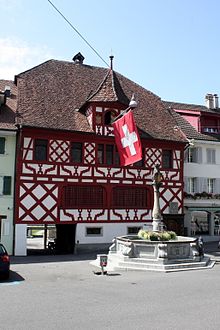Seraphin Xaver Weingartner

Seraphin Xaver Weingartner (born February 4, 1844 in Lucerne ; † November 9, 1919 there ) was a Swiss facade and wall painter of the Düsseldorf School , designer , restorer and preservationist , art teacher and founding director of the Lucerne School of Applied Arts .
Life
Weingartner, son of the saddler Andreas Weingartner, nephew of the painter Joseph Weingartner , began to study painting at the Düsseldorf Art Academy in 1861 after taking drawing lessons at the Lucerne Cantonal School with Jakob Schwegler (1793–1866) . There he attended the elementary class with Ludwig Heitland , Andreas and Karl Müller (1861/1862), heard lectures on art history by Andreas Müller (1861–1863), took part in Karl Müller's preparatory class and Rudolf Wiegmann's construction class (1862 / 1863), took lessons in anatomy and proportion theory from Heinrich Mücke (1862–1864) and attended the painting school of the portrait and history painter Karl Ferdinand Sohn (1862–1865). For financial reasons, presumably, he returned to Lucerne in the autumn of 1865 and took a job as a drawing teacher at the local canton school. From 1868 he was also appointed to the municipal boys' school in Lucerne as a drawing teacher. During this time he went on study trips to Italy and Germany. In 1869 he became a member of the Lucerne Art Society. In 1870 he opened a free evening school for free and professional drawing in Lucerne's Krienbachschule. In 1876 he initiated the establishment of the first Swiss School of Applied Arts , the Lucerne School of Applied Arts, of which he became the founding director and remained until 1917. In 1883 he married Berta Unternährer, who gave birth to two sons and two daughters. He found his final resting place in the Friedental cemetery .
Weingartner participated in social and club life through the following memberships and activities:
- Member of the saffron guild
- Member of the Fidelitas Society
- Honorary member of the mask lovers society
- Design of the stage and costumes for the 500th anniversary of the Battle of Sempach , 1886
- Draft of the costumes for the saffron guild moving out for the 400th anniversary of the Battle of Dornach , 1899
- Member of the decoration committee at the Swiss Federal Shooting Festival in Lucerne, 1901
- Draft of the festival decoration for the patriotic drama The victory in the Schwaderloo of the saffron guild on the occasion of the Federal Rifle Festival in St. Gallen, 1904
- artistic arrangements of the Lucerne lake night festivals and Fritschi parades during the carnival
Weingartner was best known for wall paintings on house facades in Lucerne, the best examples of which date back to the 1890s. As a representative of historicism and stylistic pluralism, as well as an advocate of a “picturesque townscape”, he found models for his works in the style of the neo-renaissance and neo-Gothic in Italy, in southern Germany and with Gottfried Semper . His wall cross- shop facades combined architectural painting and ornamentation with historical and symbolic materials about history of the town or in relation to the trade in case of default. Late Romantic subjects and late Nazarene painting style of the Düsseldorf School found their way into his painterly work.
As a pedagogue, Weingartner promoted awareness of monuments and technical training, especially in the areas of metalworking, glass and decorative painting, and wood and stone sculpture. For this, he himself provided various designs. He let fellow teachers and students participate in the execution of his facade paintings. Under his aegis, the Lucerne School of Applied Arts exerted considerable influence on the development of applied arts in Switzerland. Weingartner's public reputation was reflected in his work as a federal expert on commercial education.
Works (selection)
- Renovation of the early baroque sgraffiti on the former bailiff's palace in Willisau , 1896
- Restoration of the town hall of Sempach , 1887–1891
- Exposure of the coat of arms at the Lucerne armory , 1901
- Renovation of the grisaille paintings from the late 18th century on the Sonnenberghaus on the Reuss Bridge in Lucerne, 1906
literature
- Jochen Hesse: Seraphin Weingartner. A multi-faceted artist personality of Lucerne historicism . In: Luzerner Hauskalender Meyer-Brattig , 195 (1996), pp. 69–72
- Weingartner, Seraphin Xaver . In: Hans Paffrath (Ed.): Lexicon of the Düsseldorfer Malerschule 1819–1918. Volume 3: Nabert-Zwecker. Published by the Kunstmuseum Düsseldorf in the Ehrenhof and by the Paffrath Gallery. Bruckmann, Munich 1998, ISBN 3-7654-3011-0 .
Web links
- Jochen Hesse: Weingartner, Seraphin Xaver. In: Sikart
- Jochen Hesse: Weingartner, Seraphin. In: Historical Lexicon of Switzerland .
Individual evidence
- ↑ Bettina Baumgärtel , Sabine Schroyen, Lydia Immerheiser, Sabine Teichgröb: Directory of foreign artists. Nationality, residence and studies in Düsseldorf . In: Bettina Baumgärtel (Hrsg.): The Düsseldorf School of Painting and its international impact 1819–1918 . Michael Imhof Verlag, Petersberg 2011, ISBN 978-3-86568-702-9 , Volume 1, p. 442
| personal data | |
|---|---|
| SURNAME | Weingartner, Seraphin Xaver |
| BRIEF DESCRIPTION | Swiss facade and wall painter |
| DATE OF BIRTH | February 4, 1844 |
| PLACE OF BIRTH | Lucerne |
| DATE OF DEATH | November 9, 1919 |
| Place of death | Lucerne |
